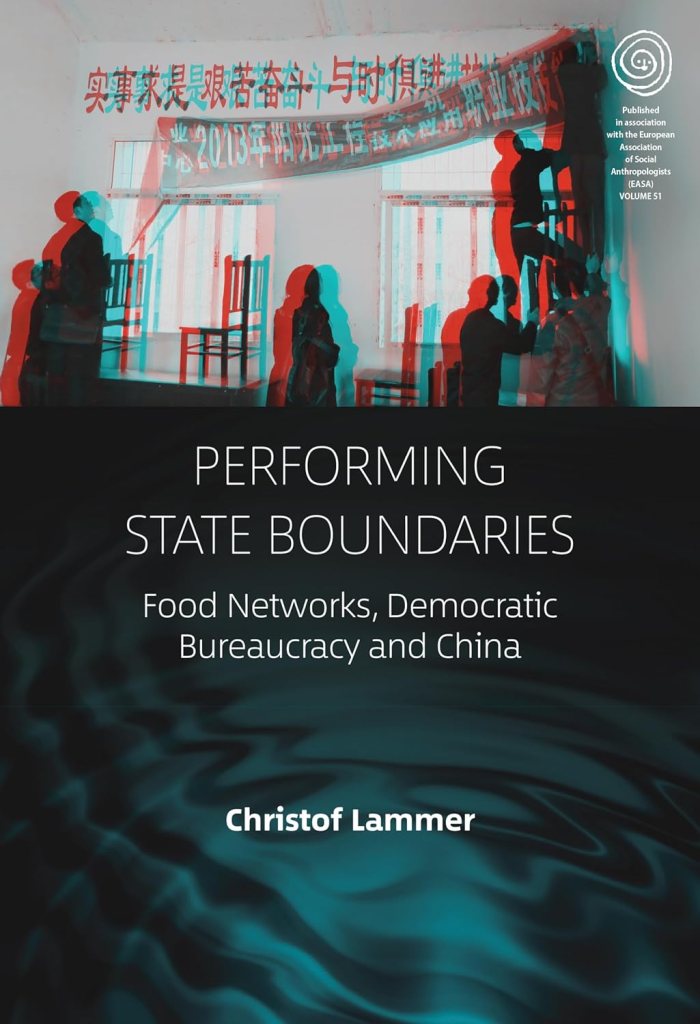
Performing State Boundaries: Food Networks, Democratic Bureaucracy and China by Christof Lammer (Berghahn 2024), 272 pages, ISBN 978-1-80539-651-2
Ellen Oxfeld (Middlebury College)
Several recently published ethnographies, while not strictly about food, focus partially on issues of food production, consumption and distribution. Performing State Boundaries: Food Networks, Democratic Bureaucracy and China is such a work. The overall focus of this book is on what the author calls “performative boundary work” among villagers, local officials, city consumers of rural organic or “ecological” products, and social welfare recipients in Daxi, a village in Qiuling Township in the Sichuan basin in China.
In the first three chapters, the author follows the travails of Dong Jie, the agronomist of Qiuling Township. Dong plays a key role linking this ecological village with urban middle-class consumers and rural development NGOS. Lammer uses the term ‘food network’ to explain the ways in which these groups and individuals are linked. Most importantly for the author’s focus on “boundary work”, boundaries between state actors and non-state actors were performed and were never set in stone.
For instance, in some of their discourse, Dong Jie and NGO staff used a language that was appealing to the urban middle-class consumers, and thus “Dong was positioned on the side of civil society and community rather than the state.” (27). Dong thus situated himself both within and sometimes against the state depending on his audience.
The Daxi Village Cooperative produced both “’certified organic’ rice, as well as vegetables that were labelled ‘ecological’ but not certified as ‘organic.” (43) Many different terms were used such as “green,” “organic,” “ecological” and “harmless.” These referred to “various certification schemes initiated by the Chinese government: only ‘ecological’ has never been an officially recognized production standard.” (43) Those espousing the virtues of “ecological” agriculture, “contrasted the organic certification process promoted by the state with the ecological agriculture supported by community and civil society; the former only required compliance with written regulations, while the latter required a personal transformation in one’s relation to nature” (43).
If one wants to understand this through the author’s framework of “performative boundary work,” between state and society, then “ecological” is a term that is “opposed to state certification.” (45) Dong Jie explained that “these two concepts were based on two ‘completely different’ modes of thinking.” (45) Organic agriculture, for Dong Jie, was affiliated with the state and its strict paradigm of trying to “’control nature.’” State organic certification was also seen as inviting fraud as people would be drawn to it through the profit motive.
Within this context, “ecological” agriculture was not simply viewed as “‘not yet organic.’” (46). Instead, “this notion understands it as fundamentally different, claiming that it is rooted in Chinese ‘traditional culture’ and standing in opposition to certification and, therefore, ‘modernity’, ‘the West’ and, finally, ‘the state.’” In this case, “the terms organic and ecological served as a marker of the boundary between state and non-state.” (46).
Different assessments of ecological versus organic food are therefore related to boundary work with the state. But nothing is set in stone. For instance, when purchasing an “ecological” product from a local agricultural cooperative, urban consumer associations might understand the personal relations and lack of a set standard as possible “corruption” which could get in the way of objective certification. On the other hand, they might understand “ecological” agriculture as more suffused with personal relations which enabled transparency. Within this latter framework, imperfect looking produce, not wrapped up or appearing uniform, was viewed as a further index of transparency.
The focus on ecological agriculture, consumer associations, and shifting meanings of the state, modernity, and traditional culture is used by the author to examine boundary work between citizens and state. But further chapters examine other domains of action unrelated to food. These may be of more interest to scholars interested in issues of social welfare in China.
In particular, later chapters examine the shifting standards for dibao (rural welfare). Village members were originally brought into the process of vetting fellow villagers as deserving or undeserving of welfare based on their circumstances. But over time, such vetting by village members was replaced by a more top-down yet uniform standard designed to avoid “cheating.” Dibao, like food labeling, also embodies contradictions in the process of boundary making between state and society. On the one hand, receiving such social welfare can be viewed as embodying “too much kinship” as recipients may use kin connections while applying to get a more favorable outcome on their application. On the other hand, it is also connected to “too little kinship,” because the applicants are viewed as having adult children who are not filial enough to take care of their parents, and who are shirking their responsibilities. Depending on how they situate themselves while assessing the applications, village officials may be seen as enforcing a top-down standard coming from the state or as advocates utilizing a standard informed by knowledge of local situations.
The first parts of the book are valuable for food anthropologists who are interested in the roles of consumers, producers and the state in the creation and response to food standards. While it is often assumed that there is little room for maneuver in authoritarian political systems such as that of China, one gets a more nuanced and shifting picture in this ethnography based on deep study of a local situation. This book will also be of interest to those interested in the constantly transforming cultural and political landscape of rural China. However, it must also be noted that the writing is dense and not always accessible. As such, it will be of use to specialists but is not recommended for undergraduates
